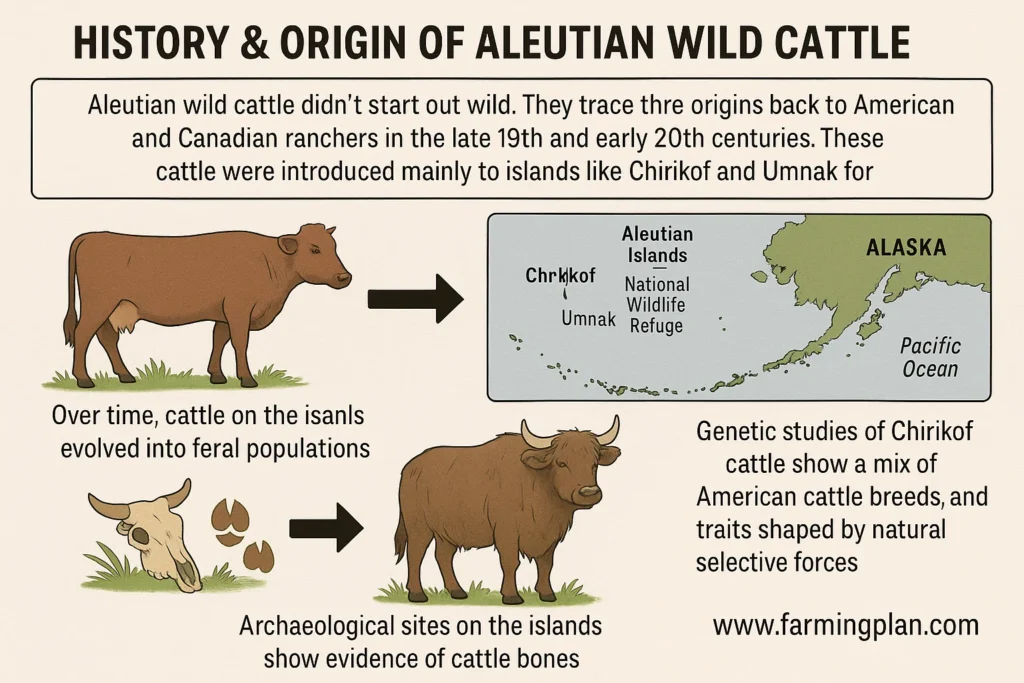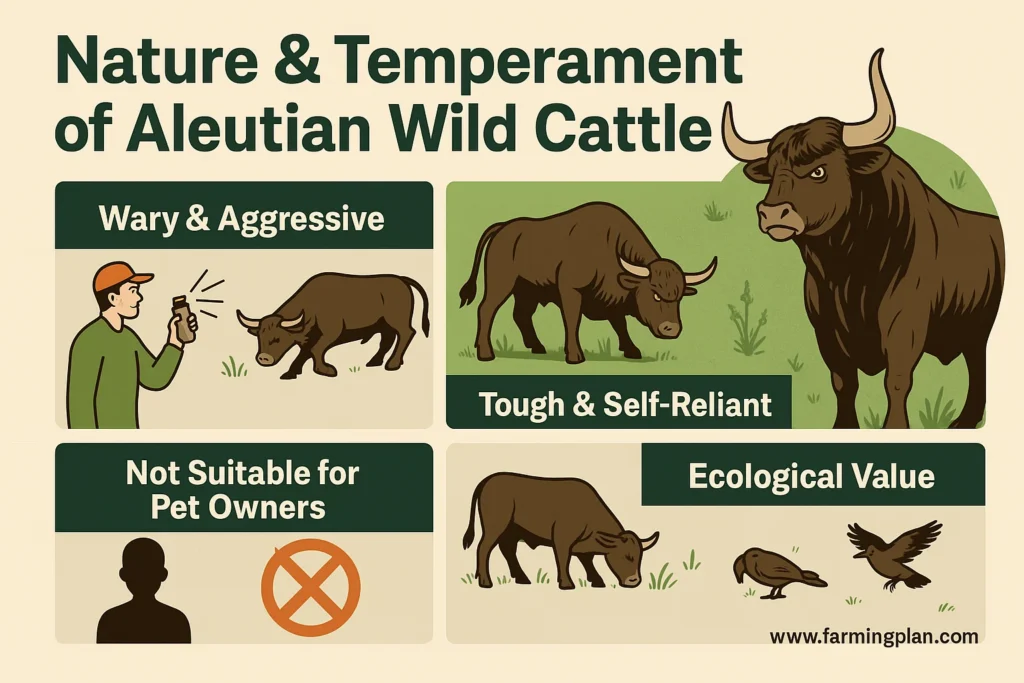When you think of cattle in Alaska, fenced farms might come to mind—but the Aleutian Islands tell a different story. Aleutian Wild Cattle are feral herds that have roamed freely on remote islands like Chirikof and Umnak for over a century. These tough animals adapted to harsh weather and scarce food, creating a unique cattle population found nowhere else in America. In this article, I’ll explore their fascinating history, behavior, and role in Alaska’s wildlife. Whether you’re a breeder, farmer, or just curious about wild cattle, you’ll discover insights on hunting, genetics, and managing these remote island herds.

History & Origin of Aleutian Wild Cattle
Aleutian Wild Cattle didn’t start out wild. They trace their origins back to cattle brought to the Aleutian Islands by American and Canadian ranchers in the late 19th and early 20th centuries. These cattle were introduced mainly to islands like Chirikof and Umnak for ranching purposes. However, due to the remote location and difficult conditions, many cattle either escaped or were released, eventually forming unmanaged herds.

The Aleutian Islands, part of the Alaska Maritime National Wildlife Refuge, are rugged and isolated, spanning hundreds of miles across the Pacific. Over time, the cattle on these islands evolved away from their managed roots into feral populations. Archaeological sites on the islands show evidence of cattle bones and hoof prints dating back to when ranchers first introduced them, revealing the long history of these animals in the archipelago. Interestingly, genetic studies of the Chirikof cattle show a mix of American cattle breeds and traits shaped by natural selective forces in the harsh island environment. These herds provide a glimpse into early cattle breeds before modern commercial ranching practices dominated.
Read More: Gelbvieh Cattle: Origin of a Cattle Breed
Characteristics of Aleutian Wild Cattle
Aleutian Wild Cattle display a variety of characteristics shaped by their feral lifestyle. These cattle often weigh less than commercial beef breeds but can still reach impressive sizes, with some bulls tipping the scales near 1,000 kilograms. Their coats vary in color, often showing the black-capped heads and rugged, thick fur adapted for cold weather. The cattle’s hooves are strong and tough, adapted to navigate the rocky and often wet terrain of the islands.

Because they’ve lived unmanaged for so long, Aleutian cattle exhibit hardiness and resilience. They tend to have leaner builds than typical commercial breeds, with muscular frames that help them survive on the limited grazing available on islands like Umnak, which spans 686 square miles but has sparse pasture In terms of breed variation, these cattle show genetic traits from various American breeds introduced by early ranchers. The genetic relatedness among the herds suggests a mix of influences but with natural selection favoring traits fit for survival in the wild.
Read More: Fleckvieh Cattle: The Spotted German Breed
Nature & Temperament of Aleutian Wild Cattle
Aleutian Wild Cattle behave differently from domesticated herds. Being feral, they are naturally wary of humans and other animals. Bulls, especially during the rutting season, can be aggressive and protective of their territory and cows. These animals are tough and self-reliant, often roaming large tracts of land in search of food. Due to their wild nature, they are not suitable for casual pet owners or beginners. Handling these cattle requires experience and caution. Hunters and wildlife managers often approach them with pepper spray and other protective gear to avoid conflict.

Despite their wild temperament, these cattle provide important ecological value. Their grazing impacts the island vegetation, and their presence influences local bird habitats and other wildlife. Understanding their behavior helps ranchers and wildlife officials manage conflicts over land use, especially as these islands also host critical bird feeder habitats and archaeological sites. The Aleutian Wild Cattle play a crucial role in maintaining the balance of the local ecosystem, making their management a significant aspect of wildlife conservation.
Read More: Afrikaner Cattle: The Ultimate Hardy Breed for Heat, Strength & Superior Beef
Food & Diet
Feeding wild cattle on remote islands isn’t like feeding farm cattle. Aleutian Wild Cattle survive primarily by grazing on native grasses, shrubs, and other available forage. Their diet depends heavily on the island’s vegetation, which can be sparse and challenging to digest.
In managed settings, these cattle require a balanced diet similar to other beef breeds—grassfed hay, grains, minerals, and plenty of fresh water. But in their natural feral state, their diet is limited to what they can find, including some tough island plants. Because the islands experience harsh weather, food availability fluctuates seasonally. During winter months, when snow and ice cover the land, the cattle rely on stored fat and whatever vegetation they can uncover. This natural, selective diet contributes to their hardiness but also makes them slower growing and leaner than commercial breeds.
Usage & Purpose
While Aleutian Wild Cattle are mostly unmanaged and feral, they still hold value for certain purposes. For some Alaska ranchers and wildlife enthusiasts, these cattle represent a unique breed heritage, offering genetic diversity valuable for conservation and breeding programs. They are also part of the local hunting culture. Hunting Chirikof Island cattle is allowed under regulated programs, helping control the herd size and maintain ecological balance. Hunters seek the challenge and the opportunity to harvest wild beef from a remote and rugged environment.
For conservationists, the cattle are both a curiosity and a challenge. They can impact native wildlife and vegetation, prompting discussions about sustainable cattle management on the islands. Some ranchers and government agencies have plans to manage or remove cattle to protect native bird habitats and archaeological sites. However, managing these feral herds also presents unique challenges, such as the need to balance conservation efforts with the preservation of the breed’s unique genetic traits. Understanding these challenges and the potential benefits of managing the Aleutian Wild Cattle can help to foster a deeper appreciation for these unique animals.
Special Features
Their genetic makeup shows a fascinating blend of early American cattle breeds, preserved through isolation and natural selection. These genetics might hold clues for breeders interested in traits like disease resistance, hardiness, and grassfed beef quality. The cattle’s thick coats and robust hooves are natural tools for island life. Another unique trait is their unmanaged herd structure, where natural social orders form without human intervention—something rarely seen in most cattle breeds today.
Wild Cattle In The Aleutian Islands Are A Living Link Between History And Nature — A True Testament To The Spirit Of Survival.
Health Issues & Prevention
Feral Aleutian Wild Cattle face natural health challenges, including parasites, injuries from rough terrain, and nutritional stress during harsh winters. Without human care, diseases can spread quickly in unmanaged herds.
In managed situations, routine veterinary care is vital. This includes vaccinations, parasite control, and hoof care to prevent infections or lameness. Because these cattle are adapted to cold, wet climates, they are prone to respiratory illnesses if overcrowded or stressed. Preventive care for Aleutian cattle also involves monitoring population sizes to avoid overgrazing and ecological damage. If you’re a breeder or rancher, keeping detailed genetic samples and health records helps preserve breed quality and prevent inherited diseases.
Step-by-Step Farming Guide – Raising Aleutian Wild Cattle Successfully
Step 1: Preparing Land and Shelter
Before introducing Aleutian Wild Cattle, secure a large pasture with good-quality grass and shrubs. Provide sturdy shelter against cold winds and wet weather—think solid barns or windbreaks. These cattle need space to roam but also protection from storms common in Alaska.
Step 2: Selecting Healthy Animals
Start with cattle that show strong genetics and good health. Look for bulls and cows with thick coats, sound hooves, and no signs of disease. Genetic testing can help ensure you maintain the unique traits of the Aleutian herd.
Step 3: Feeding and Nutrition Management
Feed your cattle a diet rich in grass and forage, supplemented with minerals and hay during scarce months. Monitor body condition closely and adjust feed as necessary to prevent malnutrition.
Step 4: Health Checks and Veterinary Care
Schedule regular vet visits to check for parasites, respiratory issues, and hoof health. Vaccinate according to local guidelines and keep detailed health records.
Step 5: Managing Herd and Breeding
Monitor herd size to avoid overpopulation and land damage. Select breeding pairs that preserve desired traits. If hunting is part of your management, coordinate with wildlife authorities for sustainable practices.
Expert Tips & Best Practices for Aleutian Wild Cattle
- Always keep pepper spray or protective equipment handy when handling feral cattle.
- Monitor grazing impact to protect native bird habitats and archaeological sites.
- Use genetic testing to maintain breed diversity and prevent inbreeding.
- Establish fencing that can withstand the harsh Aleutian winds and prevent escapes.
- Collaborate with Alaska Maritime Wildlife Refuge for sustainable herd management.
- Rotate pastures to allow vegetation recovery.
- Provide supplemental feed during harsh winters to reduce stress.
- Document cattle hoof prints and skulls to track herd movement and history.
- Engage with local hunters for controlled cattle population reduction.
- Use sturdy cattle conveyance landing craft for transport in rough island waters.
FAQ
Can you hunt feral cows in Alaska’s Aleutian Islands?
Yes, regulated hunting of feral Aleutian cattle is allowed on some islands like Chirikof, helping manage herd sizes and ecological balance.
What is the typical size of Aleutian Wild Cattle bulls?
These bulls can weigh up to around 1,000 kilograms but are generally leaner and smaller than commercial beef breeds.
Are Aleutian Wild Cattle related to commercial American breeds?
Yes, genetic studies show a mix of American breeds introduced by early ranchers, shaped by natural selection in the wild.
Where can you find Aleutian Wild Cattle for sale?
Occasionally, cattle from the Aleutian herds, especially from islands like Umnak, are sold through specialized breeders or auctioned by government agencies.
What are the main challenges in managing Aleutian Wild Cattle?
Challenges include harsh weather, limited food, protecting native wildlife habitats, and preventing overgrazing on fragile island ecosystems.
Conclusion
Aleutian Wild Cattle tell a unique story of resilience and natural history in Alaska. Living on isolated islands like Chirikof and Umnak, these feral herds show incredible genetic diversity and wild beauty. They pose both a wildlife challenge and a valuable resource, needing careful management that balances conservation, local traditions, and ranching. Whether you’re interested in their genetics, hunting, or just curious about Alaska’s wild cattle, there’s much to admire and learn. I encourage farmers, breeders, and animal lovers to support efforts protecting these animals’ heritage while promoting sustainable practices. The Aleutian Islands offer a rare chance to see cattle truly living off the beaten path—ready for anyone who wants to explore or get involved.

